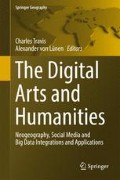Abstract
Originally launched in 2008 and then acquired by Google in summer 2013, Waze is a satellite navigation app which uses crowd-sourced information to help drivers find the quickest route to their destination in real time. With reported 50 million users in 2013, the company claims to be one of the largest community-based traffic and navigation apps, and its success is an indicator that the togetherness it advertises is more than a catchy slogan; for Waze, strength is in numbers. Although the company reserves the right to disclose how many of its users are based in the UK, they disclose that London alone has a reported 80,000 Wazers. The app’s appeal to an audience of drivers is due to a variety of factors which include the fact that it is free to use, its gamified nature, and the ability it has to redirect drivers’ navigation when road conditions change, minimizing the time drivers need to spend on the road. This chapter conceptually explores Waze as an extension of the car. By discussing the act of physical driving alongside digital guiding, it capitalises on the hybridity between person, space, and machine (referring both to the vehicle and the app). Waze functions via direct participation of the user: it sets a route from an origin to a destination by calculating the quickest route to minimise travel time and petrol consumption, but if the driver experiences any delays along the route, the app provides a platform for the user to report the problem to the server. Waze then reroutes any vehicles which have been sent down that same route. This idea of users working together to outsmart traffic brings about a notion of community but one that is transactional and detached. The drivers do not know each other; they appear as small avatars zooming through a digital map, but they often feel a sense of responsibility to the app to provide data to help other users. Through studying Waze, the chapter seeks to explore the alternate forms of community and digital citizenship that manifests through the app, as well as rethinking the public/private coding of the road space. The interior of the car, often associated with a solitary disconnection to the external environment is re-examined as a penetrable space for digital forms of social interaction. The act of driving, when coupled with Waze, takes on a complex role enabling new spatial relations and subjectivities.
Access this chapter
Tax calculation will be finalised at checkout
Purchases are for personal use only
References
Borden I (2013) Drive: journeys through film, cities and landscapes. Reaktion, London
Bovy PHL, Stern E (1990) Route choice: wayfinding in transport networks. kluwer Academic, Dordrecht
Gane N (2006) When we have never been human, what is to be done? Interview with Donna Haraway. Theory Cult Soc 23(7/8):135–158
Hansen MBN (2004) New philosophy for new media. MIT Press, Cambridge (MA) & London
Hayles NK (2005) My mother was a computer: digital and literary texts. University of Chicago Press, Chicago & London
Merriman P (2007) Driving spaces: a cultural-historical geography of England’s M1 motorway. Blackwell, Malden (Ma.)
Pickles J (2004) A history of spaces: cartographic reason, mapping, and the geo-coded world. Routledge, London
Pooley CG, Turnbull J, Adams M (2005) A mobile century?: Changes in everyday mobility in Britain in the twentieth century. Ashgate, Aldgate
Turkle S (2011) Alone together: why we expect more from technology and less from each other. Basic, New York
Virilio P (1998) Dromoscopy, or the ecstasy of enormities. Wide Angle 20(3):11–22, translated by Edward R. O’Neil
Author information
Authors and Affiliations
Corresponding author
Editor information
Editors and Affiliations
Rights and permissions
Copyright information
© 2016 Springer International Publishing Switzerland
About this chapter
Cite this chapter
Ramos, R. (2016). Driving Screens: Space, Time, and Embodiment in the Use of Waze. In: Travis, C., von Lünen, A. (eds) The Digital Arts and Humanities. Springer Geography. Springer, Cham. https://doi.org/10.1007/978-3-319-40953-5_8
Download citation
DOI: https://doi.org/10.1007/978-3-319-40953-5_8
Published:
Publisher Name: Springer, Cham
Print ISBN: 978-3-319-40951-1
Online ISBN: 978-3-319-40953-5
eBook Packages: Earth and Environmental ScienceEarth and Environmental Science (R0)

